by Art Merrill | Contributing Editor
With muzzleloaders, every load is a handload, so it’s no stretch to include them within our purview here. If you’ve been around muzzleloaders for a while then maybe you recall the “Tap-O-Cap” from Dixie Gun Works. That tool looked rather like a pair of scissors and worked like a standard office hole-punch for making percussion caps from aluminum drink cans. Instructions in the catalog, if memory serves, was to use a child’s toy cap as the primer material. The Tap-O-Cap has been discontinued for some time and, as Brian Nixon at Sharp Shooter, who brings us the #11 Percussion Cap Maker, noticed, the patent on it expired.
That expiration might be moot because Sharp Shooter’s new #11 Percussion Cap Maker doesn’t work in the same way, instead utilizing a two-piece anvil and punch arrangement. The quick explanation of its operation is that you cut an aluminum beverage can into ¾” strips, slide a strip into the anvil, and then tap the punch with a soft mallet to knock out a percussion cap cup. Primer material is Sharp Shooter’s own powdered Prime-All; fill the cap with Prime-All, add a drop of acetone or alcohol, allow to dry for 24 hours and voila: – homemade percussion cap.
One, two…
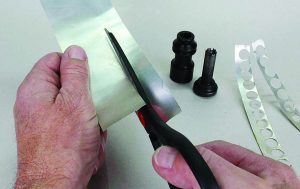
1: Cut an aluminum beverage can into strips…
Making percussion caps is a simple, five-step process of cut, punch, mix, fill and drop. First, cut the top and bottom from an aluminum beverage can. Cut the remainder of the can lengthwise and flatten by running it over the edge of your loading bench, then cut it into strips about ¾” wide. Common, sturdy scissors work great for this operation.
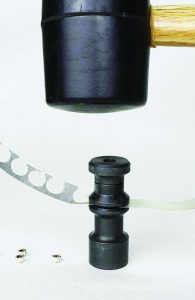
2: …punch out percussion caps…
Remove the punch from the percussion cap maker, insert a strip into the gap in the side of the anvil/base, insert the punch and then tap with a soft mallet. My lazy man’s technique was to simply allow a one-pound rubber mallet to fall of its own weight onto the punch. It isn’t necessary to whack the punch hard; in fact, you could use the palm of your hand rather than a rubber mallet. I did so out of curiosity and it works, but I’m sure my palm would have felt the effects if I’d continued for any length of time.
After tapping, remove and invert the punch to allow the formed cap to travel through the hollow center and fall out the top. A piece of wire comes in handy for encouraging the occasional reluctant cap to exit. The aluminum caps are not too easily crushed, but the slightest breeze or errant move can send them skittering across your bench.
…three…
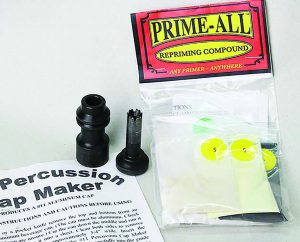
3: …mix Prime-All…
As you can imagine, shipping loose, impact sensitive primer material would be extremely hazardous. Sharp Shooter circumvents danger (and HAZMAT shipping fees) by packaging Prime-All chemicals in four separate plastic sachets. We mix the powdered chemicals at the loading bench in very small batches utilizing the tiny double-ended plastic scoop and simple instructions provided. A common shot glass works very well as a mixing container, and as an insulator helps preclude any static electrical charge buildup that might cause some unintentional excitement.
Mixing technique appears to be important to making the caps reliably go “bang.” First, crush any tiny lumps that may have formed in the powdered chemicals. Thoroughly mix only two together, then add the third chemical and mix thoroughly again before adding the fourth. The key word here is, “thoroughly.” A single batch is good for about 8-10 caps.
…four, five
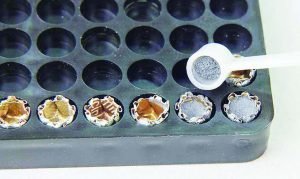
4: …fill caps with Prime-All mixture…
I discovered that an empty plastic tray used for shipping/storing 100 large size rifle or pistol primers is just about perfect as a kind of loading block for containing the caps. Filling the caps with Prime-All takes finesse, and any but the smallest hands will find a pair of tweezers handy. You may want tweezers or forceps anyway because the serrated edges of the formed caps tend to stick to the fingers, causing spilling of the loose Prime-All while working.
Use the tiny plastic scoop that came with the Prime-All to fill the caps; expect plenty of spillage while performing this maneuver. Adding a drop or two of acetone or denatured alcohol (the kind used for camp stoves) will settle the Prime-All a bit below the cap rim. Allow to dry 24 hours.
Assuring a ‘bang’
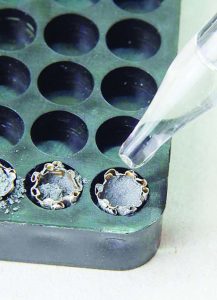
5: …add a drop of denatured alcohol. Done!
Unfortunately, the wetted and dried Prime-All is not very durable – that is, moderately rough handling knocks the dried material out of the caps, returning it to loose powder. I tested this by placing a handful of the percussion caps in a small plastic container and shaking it to simulate the caps riding loose in a container in a pocket. Virtually all of them lost some Prime-All and a few were emptied. Some Prime-All occasionally comes loose when seating the cap on a nipple, as well, but doesn’t appear to lessen ignition.
I’ve tested Prime-All quite a bit the past year, using it to reload 22LR and 22 Magnum cartridges, and found that it requires a solid blow from a firing pin to reliably ignite. As an example, for this article, the direct hammer blow of a tiny North American Arms “Companion” cap & ball revolver failed to ignite any of these homemade percussion caps, but they gave 100 percent ignition when used on a T/C Renegade percussion muzzleloader and a Uberti clone of the 1836 Army percussion revolver. Note that Prime-All leaves a rusty red-colored residue that cleans up with standard cleaning solvents and methods.
Safety first
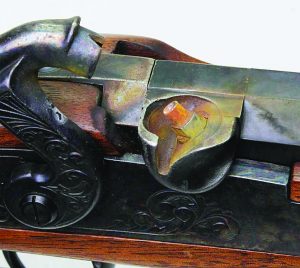
The Prime-All leaves a red, rather than gray residue.
A couple of “no duh” but nonetheless important safety notes. The cut aluminum has knife-sharp edges and will readily cut flesh; don’t get into a hurry when sliding the strip in the tool or at any other time handling the cut aluminum. The manufacturer recommends wearing gloves. When mixing the Prime-All, point the mixing container away from your face. I haven’t had an ignition while mixing, but twice I’ve had Prime-All ignite with a flash and a pop when I scraped it from unfired .22LR cases while breaking down handloaded ammo to troubleshoot ignition problems, so the potential is there.
Both handloaders and shooters of traditional style muzzleloaders tend to be the DIY types; Sharp Shooter’s #11 Percussion Cap Maker and Prime-All offer another opportunity for entertainment and experiment, as well as an option to depending solely upon commercial availability of percussion caps.
MSRP for the #11 Percussion Cap Maker is $49.95; Prime-All is $19.95 for enough to load approximately 1,500 or more percussion caps. Visit www.22lrreloader.com/store/ for more information.



